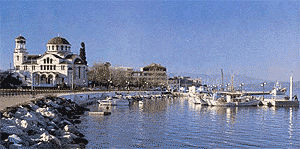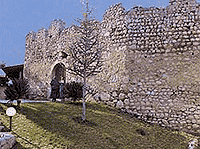A land of towering mountains and beautiful beaches, the prefecture of Fthiotida (Phthiotis) has all the prerequisites for a delightful holiday all year round.
Here you may chose to swim in isolated beaches or well known summer resorts, you can wander among mountain villages “drowned” in plane and oak trees or enjoy winter sports in modern skiing resorts and let your memory revive heroic moments of the Greek history (at Thermopylae, Alamana or Gorgopotamos).
 Add to the picture several thermal springs equipped with modern tourist facilities (Ypati, Kamena Vourla, Platystomo) and you can have an idea of the vacational possibilities offered by the area.
Add to the picture several thermal springs equipped with modern tourist facilities (Ypati, Kamena Vourla, Platystomo) and you can have an idea of the vacational possibilities offered by the area.
Lamia (220 km. from Athens), a bustling commercial city and capital of the prefecture, is built up the southwest, pine-covered slopes of Mt. Othris near the Sperhios River.
Dominating the city from a hill above it, a Frankish castle rises from the stones of the ancient acropolis. On another hill stands the 18th century chuch of Aghios Loukas (around late 19th-early 20th century) with a magnificent view of the Maliac Gulf and beyond to the shores of Evia. The Lamia museum has an interesting archaeological collection of Classical and Hellenistic finds, pottery, sculpture, statues, and Geometric figurines.
The municipal buildings, hotels and tavernas are centered around the city’s four main squares, each of whom has its own distinctive feature: the cathedral, plane trees and fountains, the statue of the Revolutionary hero Athanasios Diakos, the statue of the Greek evzone.
During your stay here, make it a point to try the local homemade egg noodles, “kourambiedes” (crushed almond cookies), and “trachana” (a form of dumpling).
The historic Thermopylae (Thermopiles) pass lies 18 km. southeast of Lamia. The statue of Leonidas and the cenotaph of his 300 Spartans remind one of the heroic 480 BC battle. The famous since antiquity thermal springs of Thermopylae, bubbling quite near, have made an important resort out of the village.
Kamena Vourla, to the north, is a popular sparesort, renowned for its therapeutic waters and dry, healthy climate. The coastal towns of the area, Aghios Konstantinos, Arkitsa – linked by ferry with Edipsos on Evia – as well as the lovely beaches of Aspronerio, Aghios Serafim and Aghios Nikolaos are pleasant places to spend a holiday especially for those who like swimming and dining on fresh fish.
There if a magnificent beach at Livanates, which also has an old church, Aghios Theodoros. Before making the turn for Atalanti, it’s worth stopping at its harbour Skala, at Malesina, with the little coastal settlement of Aghios Theologos to leeward, and Martino, famed for its delicious “myzithra” cheese (similar to ricotta).
Talantonini opposite Skala is a small picturesque island.
Next stop is Atalanti, commercial and agricultural center of the area. The catacombs of St. Athanassios at the heart of the town are of special interest. Further west of Atalanti one can visit Elatia and Tithorea, wooded areas of archaeological interest, as well as Amfiklia, one of the starting points for going up to the Parnassos ski center.
West of Lamia there is one of the most historical towns of Central Greece, Ipati. Built on the slopes of Mt. Oiti, where the homonymous national Forest, among oak arid plane trees and cypresses. The spot offers also a panoramic view to the sea. Ipati has played an important role at all eras of Greek national history.
Loutra Ipatis, identified with the town itself, is an important spa equiped with hotelier and tourist installations.
Moni Agathonos (a monastery of the 15th century) lies at 7 km from Ipati and is considered one of the most illustrious monuments. Apart from valuable historical relics the Museum of Oiti Natural History is also roofed here. The beautiful villages of Mt. Oiti, such as Pavliani covered with fir and plane trees offer a refreshing shelter during hot summer months. Makrakomi is a market town and traffic center built in Sperhios valley upon the ruins of the ancient homonymous city.
Well known for its thermal springs is the village of Platystomo (34 km west of Lamia). North of Lamia, on the way to Domokos, which is a historic town with a fine view over Thessaly valley, a side road leads to the ruins of ancient Melitaea; not far from here is built the Byzantine Monastery of the Holy Trinily (Aghia Triada). Worth visiting are also the coastl town Stilida, the tranquil fishing hamlets Karavomilos and Achladi and finally the beaches of Pelasgia and Glifa. At a distance of 3 km, stands the historic bridge of Alamana.
Here you may chose to swim in isolated beaches or well known summer resorts, you can wander among mountain villages “drowned” in plane and oak trees or enjoy winter sports in modern skiing resorts and let your memory revive heroic moments of the Greek history (at Thermopylae, Alamana or Gorgopotamos).
 Add to the picture several thermal springs equipped with modern tourist facilities (Ypati, Kamena Vourla, Platystomo) and you can have an idea of the vacational possibilities offered by the area.
Add to the picture several thermal springs equipped with modern tourist facilities (Ypati, Kamena Vourla, Platystomo) and you can have an idea of the vacational possibilities offered by the area. Lamia (220 km. from Athens), a bustling commercial city and capital of the prefecture, is built up the southwest, pine-covered slopes of Mt. Othris near the Sperhios River.
Dominating the city from a hill above it, a Frankish castle rises from the stones of the ancient acropolis. On another hill stands the 18th century chuch of Aghios Loukas (around late 19th-early 20th century) with a magnificent view of the Maliac Gulf and beyond to the shores of Evia. The Lamia museum has an interesting archaeological collection of Classical and Hellenistic finds, pottery, sculpture, statues, and Geometric figurines.
The municipal buildings, hotels and tavernas are centered around the city’s four main squares, each of whom has its own distinctive feature: the cathedral, plane trees and fountains, the statue of the Revolutionary hero Athanasios Diakos, the statue of the Greek evzone.
During your stay here, make it a point to try the local homemade egg noodles, “kourambiedes” (crushed almond cookies), and “trachana” (a form of dumpling).
The historic Thermopylae (Thermopiles) pass lies 18 km. southeast of Lamia. The statue of Leonidas and the cenotaph of his 300 Spartans remind one of the heroic 480 BC battle. The famous since antiquity thermal springs of Thermopylae, bubbling quite near, have made an important resort out of the village.

Kamena Vourla, to the north, is a popular sparesort, renowned for its therapeutic waters and dry, healthy climate. The coastal towns of the area, Aghios Konstantinos, Arkitsa – linked by ferry with Edipsos on Evia – as well as the lovely beaches of Aspronerio, Aghios Serafim and Aghios Nikolaos are pleasant places to spend a holiday especially for those who like swimming and dining on fresh fish.
There if a magnificent beach at Livanates, which also has an old church, Aghios Theodoros. Before making the turn for Atalanti, it’s worth stopping at its harbour Skala, at Malesina, with the little coastal settlement of Aghios Theologos to leeward, and Martino, famed for its delicious “myzithra” cheese (similar to ricotta).
Talantonini opposite Skala is a small picturesque island.
Next stop is Atalanti, commercial and agricultural center of the area. The catacombs of St. Athanassios at the heart of the town are of special interest. Further west of Atalanti one can visit Elatia and Tithorea, wooded areas of archaeological interest, as well as Amfiklia, one of the starting points for going up to the Parnassos ski center.
West of Lamia there is one of the most historical towns of Central Greece, Ipati. Built on the slopes of Mt. Oiti, where the homonymous national Forest, among oak arid plane trees and cypresses. The spot offers also a panoramic view to the sea. Ipati has played an important role at all eras of Greek national history.
Loutra Ipatis, identified with the town itself, is an important spa equiped with hotelier and tourist installations.
Moni Agathonos (a monastery of the 15th century) lies at 7 km from Ipati and is considered one of the most illustrious monuments. Apart from valuable historical relics the Museum of Oiti Natural History is also roofed here. The beautiful villages of Mt. Oiti, such as Pavliani covered with fir and plane trees offer a refreshing shelter during hot summer months. Makrakomi is a market town and traffic center built in Sperhios valley upon the ruins of the ancient homonymous city.
Well known for its thermal springs is the village of Platystomo (34 km west of Lamia). North of Lamia, on the way to Domokos, which is a historic town with a fine view over Thessaly valley, a side road leads to the ruins of ancient Melitaea; not far from here is built the Byzantine Monastery of the Holy Trinily (Aghia Triada). Worth visiting are also the coastl town Stilida, the tranquil fishing hamlets Karavomilos and Achladi and finally the beaches of Pelasgia and Glifa. At a distance of 3 km, stands the historic bridge of Alamana.

